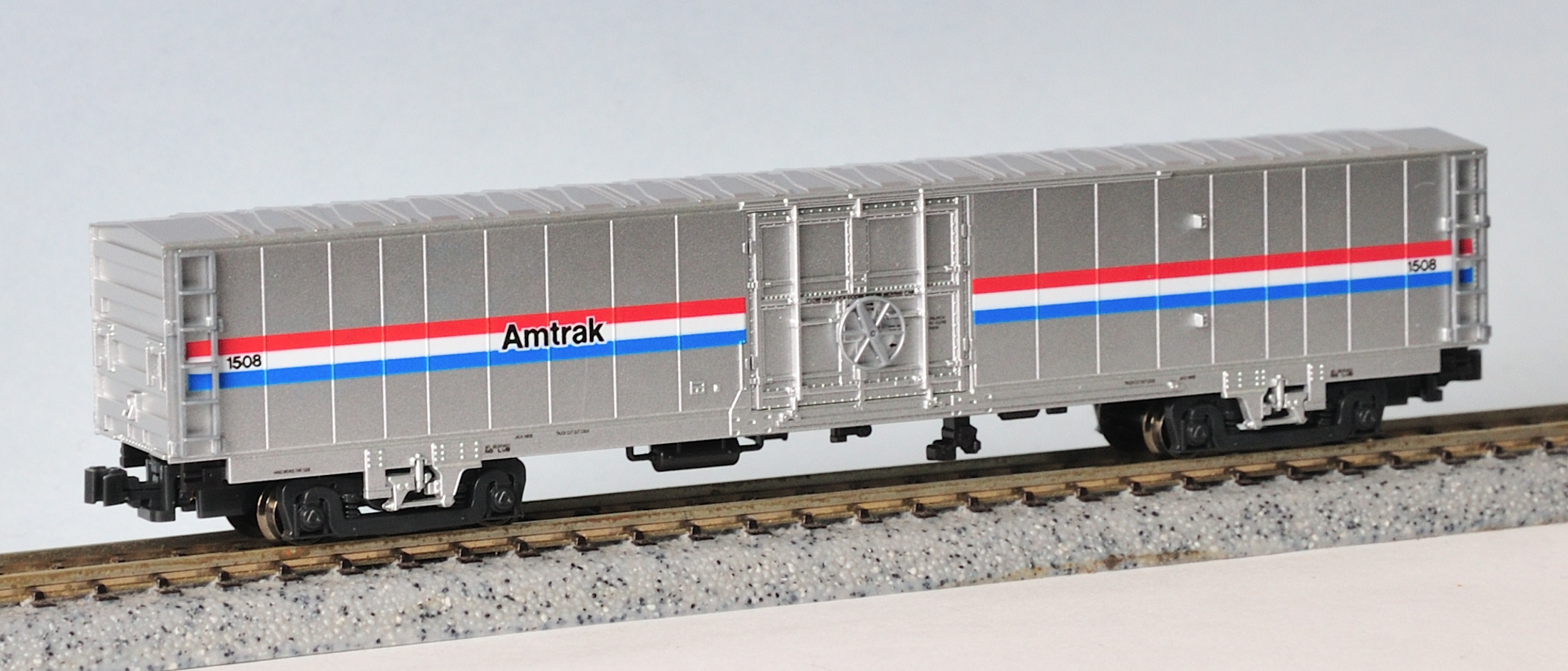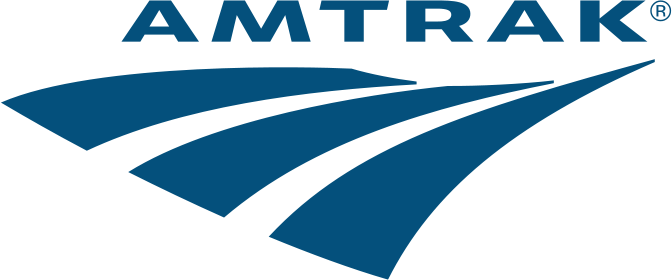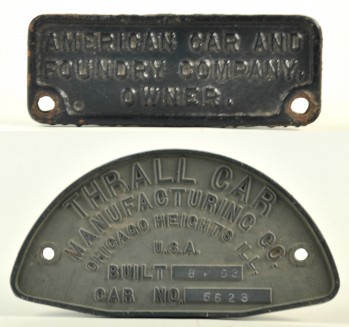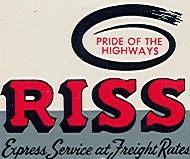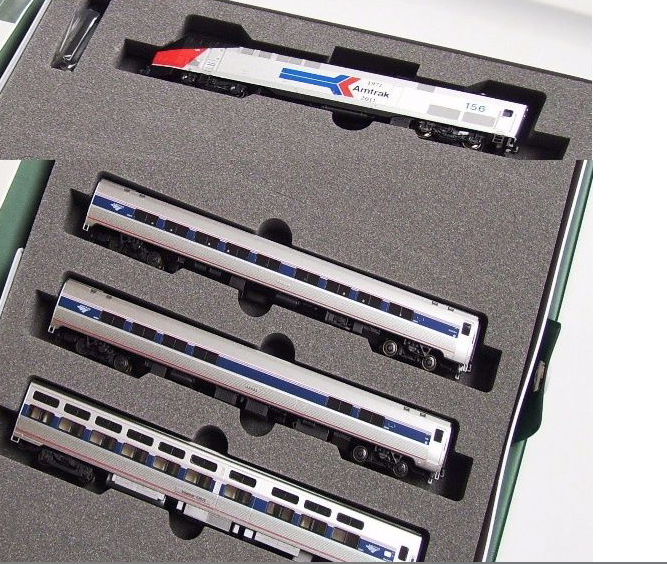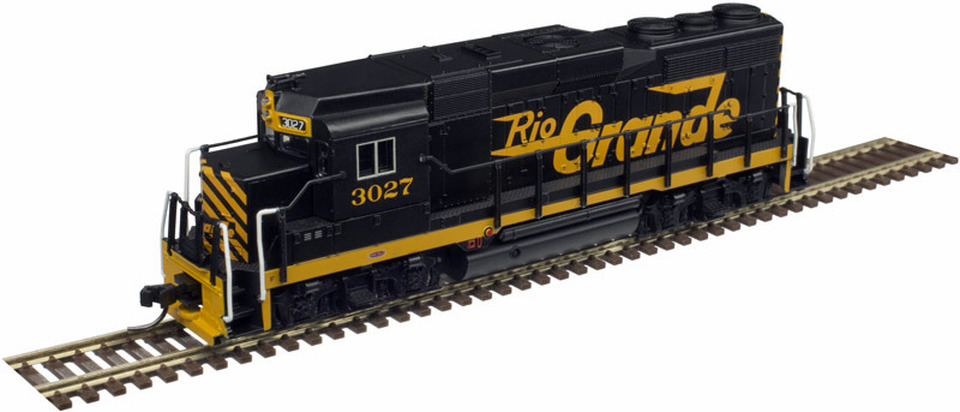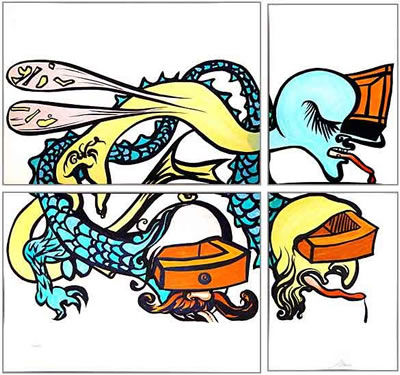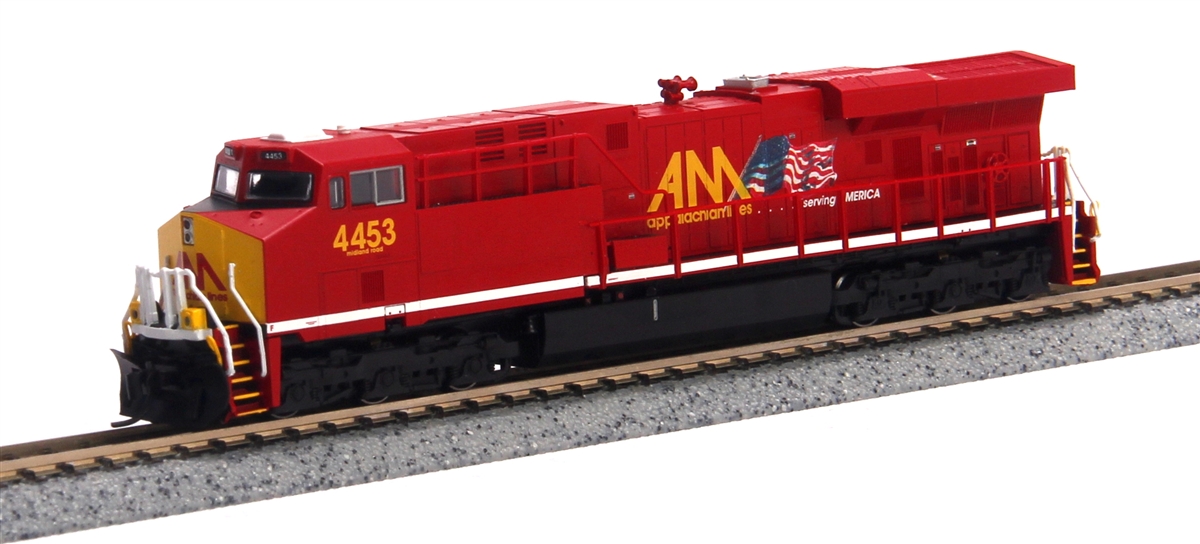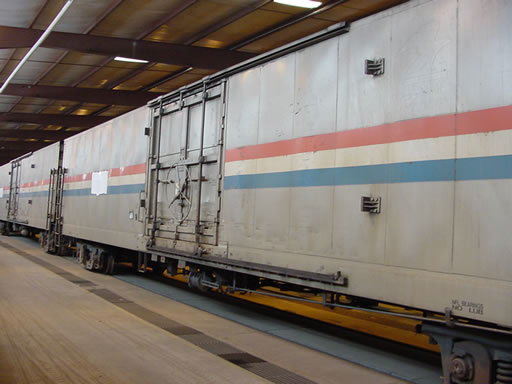Model Information: Introduced in 2002. Model based on Amtrak MHC-2 cars.
Trucks have electrical pickup for installation of aftermarket End of Train/Flashing Rear End Devices (Note: Kato does not manufacture EoT/FRED kits)
Trucks have electrical pickup for installation of aftermarket End of Train/Flashing Rear End Devices (Note: Kato does not manufacture EoT/FRED kits)
Prototype History: Late in the 1980's, Amtrak's California Zephyr trains began to run new box cars called "material handling cars" The original 1400-series MHC-1 cars were built by Thrall in 1986 utilizing rebuilt trucks from former REA express cars with a short wheelbase.The MHC cars had pass-through cabling for HEP and usually operated on the head end of the train. The Southwest Chief usually had four or five daily. The MHCs were used primarily for handling bulk mail.
In 1989 Amtrak began receiving a second version of the MHC, the MHC-2, which carry road numbers in the 1500-series. These cars differed in some notable ways. The trucks were a new design that had a longer wheelbase than the earlier cars. Further, there was a body snubber anchor mounted on the sides of the car above each truck. These two details are the most obvious differences between the two car series, however the body and roof are entirely different from the earlier cars.
Unfortunately, the express-freight business indeed turned out to be a loser, particularly because Amtrak could not manage to complete the network expansion that it announced when it started handling the traffic. That resulted in the conventional boxcars, and later the ExpressTrak reefers, being parked in 2003.
Read more on UtahRails.com.
In 1989 Amtrak began receiving a second version of the MHC, the MHC-2, which carry road numbers in the 1500-series. These cars differed in some notable ways. The trucks were a new design that had a longer wheelbase than the earlier cars. Further, there was a body snubber anchor mounted on the sides of the car above each truck. These two details are the most obvious differences between the two car series, however the body and roof are entirely different from the earlier cars.
Unfortunately, the express-freight business indeed turned out to be a loser, particularly because Amtrak could not manage to complete the network expansion that it announced when it started handling the traffic. That resulted in the conventional boxcars, and later the ExpressTrak reefers, being parked in 2003.
Read more on UtahRails.com.
Road Name History: The National Railroad Passenger Corporation, doing business as Amtrak, is a passenger railroad service that provides medium- and long-distance intercity service in the contiguous United States. Founded in 1971 through the government-sponsored consolidation of most of the remaining U.S. passenger rail companies, it is partially government-funded yet operated and managed as a for-profit corporation.
Amtrak operates more than 300 trains each day on 21,300 miles (34,000 km) of track with select segments having civil operating speeds of 150 mph (240 km/h) and connecting more than 500 destinations in 46 states in addition to three Canadian provinces. In fiscal year 2015, Amtrak served 30.8 million passengers and had $2.185 billion in revenue, while employing more than 20,000 people. Nearly two-thirds of passengers come from the 10 largest metropolitan areas; 83% of passengers travel on routes shorter than 400 miles. Its headquarters is at Union Station in Washington, D.C.
The name "Amtrak" is a portmanteau of the words "America" and "trak", the latter itself a sensational spelling of "track".
Read more on Wikipedia.
Amtrak operates more than 300 trains each day on 21,300 miles (34,000 km) of track with select segments having civil operating speeds of 150 mph (240 km/h) and connecting more than 500 destinations in 46 states in addition to three Canadian provinces. In fiscal year 2015, Amtrak served 30.8 million passengers and had $2.185 billion in revenue, while employing more than 20,000 people. Nearly two-thirds of passengers come from the 10 largest metropolitan areas; 83% of passengers travel on routes shorter than 400 miles. Its headquarters is at Union Station in Washington, D.C.
The name "Amtrak" is a portmanteau of the words "America" and "trak", the latter itself a sensational spelling of "track".
Read more on Wikipedia.
Brand/Importer Information: KATO U.S.A. was established in 1986, with the first U.S. locomotive model (the GP38-2, in N-Scale) released in 1987. Since that time, KATO has come to be known as one of the leading manufacturers of precision railroad products for the modeling community. KATO's parent company, Sekisui Kinzoku Co., Ltd., is headquartered in Tokyo, Japan.
In addition to producing ready-to-run HO and N scale models that are universally hailed for their high level of detail, craftsmanship and operation, KATO also manufactures UNITRACK. UNITRACK is the finest rail & roadbed modular track system available to modelers today. With the track and roadbed integrated into a single piece, UNITRACK features a nickel-silver rail and a realistic-looking roadbed. Patented UNIJOINERS allow sections to be snapped together quickly and securely, time after time if necessary.
The Kato U.S.A. office and warehouse facility is located in Schaumburg, Illinois, approximately 30 miles northwest of Chicago. All research & development of new North American products is performed here, in addition to the sales and distribution of merchandise to a vast network of wholesale representatives and retail dealers. Models requiring service sent in by hobbyists are usually attended to at this location as well. The manufacturing of all KATO products is performed in Japan.
Supporters of KATO should note that there is currently no showroom or operating exhibit of models at the Schaumburg facility. Furthermore, model parts are the only merchandise sold directly to consumers. (Please view the Parts Catalog of this website for more specific information.)
In addition to producing ready-to-run HO and N scale models that are universally hailed for their high level of detail, craftsmanship and operation, KATO also manufactures UNITRACK. UNITRACK is the finest rail & roadbed modular track system available to modelers today. With the track and roadbed integrated into a single piece, UNITRACK features a nickel-silver rail and a realistic-looking roadbed. Patented UNIJOINERS allow sections to be snapped together quickly and securely, time after time if necessary.
The Kato U.S.A. office and warehouse facility is located in Schaumburg, Illinois, approximately 30 miles northwest of Chicago. All research & development of new North American products is performed here, in addition to the sales and distribution of merchandise to a vast network of wholesale representatives and retail dealers. Models requiring service sent in by hobbyists are usually attended to at this location as well. The manufacturing of all KATO products is performed in Japan.
Supporters of KATO should note that there is currently no showroom or operating exhibit of models at the Schaumburg facility. Furthermore, model parts are the only merchandise sold directly to consumers. (Please view the Parts Catalog of this website for more specific information.)
Item created by: gdm on 2016-02-22 13:56:41. Last edited by gdm on 2023-02-27 15:21:53
If you see errors or missing data in this entry, please feel free to log in and edit it. Anyone with a Gmail account can log in instantly.
If you see errors or missing data in this entry, please feel free to log in and edit it. Anyone with a Gmail account can log in instantly.


